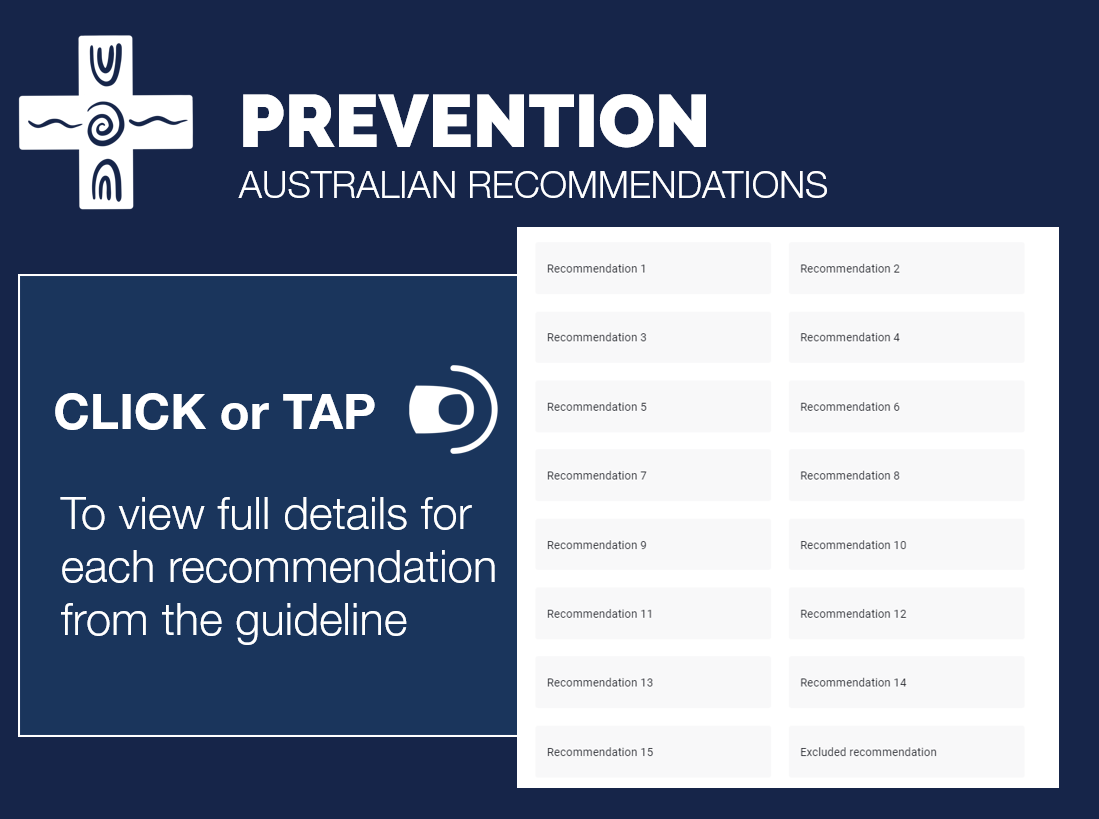

PREVENTION RECOMMENDATION LIST | |
RECOMMENDATION 1 | |
Examine a person with diabetes at very low risk of foot ulceration (IWGDF risk 0) annually for signs or symptoms of loss of protective sensation and peripheral artery disease, to determine if they are at increased risk for foot ulceration. (GRADE strength of recommendation: Strong; Quality of evidence: Low) | |
RECOMMENDATION 2 | |
Screen a person with diabetes at risk of foot ulceration (IWGDF risk 1-3) for: a history of foot ulceration or lower-extremity amputation; diagnosis of end-stage renal disease; presence or progression of foot deformity; limited joint mobility; abundant callus; and any pre-ulcerative sign on the foot. Repeat this screening once every 6-12 months for those classified as IWGDF risk 1, once every 3-6 months for IWGDF risk 2, and once every 1-3 months for IWGDF risk 3. (Strong; Low) | |
RECOMMENDATION 3 | |
Instruct a person with diabetes who is at risk of foot ulceration (IWGDF risk 1-3) to protect their feet by not walking barefoot, in socks without shoes, or in thin-soled slippers, whether indoors or outdoors. (Strong; Low) | |
RECOMMENDATION 4 | |
Instruct, and after that encourage and remind, a person with diabetes who is at risk of foot ulceration (IWGDF risk 1-3) to: inspect daily the entire surface of both feet and the inside of the shoes that will be worn; wash the feet daily (with careful drying, particularly between the toes); use emollients to lubricate dry skin; cut toe nails straight across; and, avoid using chemical agents or plasters or any other technique to remove callus or corns. (Strong; Low) | |
RECOMMENDATION 5 | |
Provide structured education to a person with diabetes who is at risk of foot ulceration (IWGDF risk 1-3) about appropriate foot self-care for preventing a foot ulcer. (Strong; Low) | |
RECOMMENDATION 6 | |
Consider instructing a person with diabetes who is at moderate or high risk of foot ulceration (IWGDF risk 2-3) to self-monitor foot skin temperatures once per day to identify any early signs of foot inflammation and help prevent a first or recurrent plantar foot ulcer. The implementation of this recommendation is contingent on validated, user-friendly and affordable systems becoming approved and available in Australia. If the temperature difference is above-threshold between similar regions in the two feet on two consecutive days, instruct the patient to reduce ambulatory activity and consult an adequately trained health care professional for further diagnosis and treatment. (Weak; Moderate) | |
RECOMMENDATION 7 | |
Instruct a person with diabetes who is at moderate risk for foot ulceration (IWGDF risk 2) or who has healed from a non-plantar foot ulcer (IWGDF risk 3) to wear medical grade footwear that accommodates the shape of the feet and that fits properly, to reduce plantar pressure and help prevent a foot ulcer. When a foot deformity or a pre-ulcerative sign is present, consider prescribing custom-made footwear, custom-made foot orthoses, or toe orthoses. (Strong; Low) | |
RECOMMENDATION 8 | |
Consider prescribing orthotic interventions, such as toe silicone or (semi-)rigid orthotic devices, to help reduce abundant callus in a person with diabetes who is at risk for foot ulceration (IWGDF risk 1-3). (Weak; Low) | |
RECOMMENDATION 9 | |
In a person with diabetes who has a healed plantar foot ulcer (IWGDF risk 3), prescribe medical grade footwear that has a demonstrated plantar pressure relieving effect during walking, to help prevent a recurrent plantar foot ulcer; furthermore, encourage the patient to consistently wear this footwear. (Strong; Moderate). | |
RECOMMENDATION 10 | |
Treat any pre-ulcerative sign or abundant callus on the foot, ingrown toenail, and fungal infection on the foot, to help prevent a foot ulcer in a person with diabetes who is at risk of foot ulceration (IWGDF risk 1-3). (Strong; Low) | |
RECOMMENDATION 11 | |
In a person with diabetes and abundant callus consider digital flexor tendon tenotomy for preventing a first foot ulcer. Where there is an ulcer on the apex or distal part of a non-rigid hammertoe that has failed to heal with evidence-based non-surgical treatment, consider this procedure to help prevent future ulcer recurrence. (Weak; Low) | |
RECOMMENDATION 12 | |
In a person with diabetes and a plantar forefoot ulcer that has failed to heal with evidence-based non-surgical treatment, consider Achilles tendon lengthening, single or pan metatarsal head resection, metatarsophalangeal joint arthroplasty or osteotomy, to help prevent future ulcer recurrence. (Weak; Low) | |
RECOMMENDATION 13 | |
We suggest not to use a nerve decompression procedure, in preference to accepted standards of good quality care, to help prevent a foot ulcer in a person with diabetes who is at moderate or high risk of foot ulceration (IWGDF risk 2-3) and who is experiencing neuropathic pain. (Weak; Low) | |
RECOMMENDATION 14 | |
Consider communicating to a person with diabetes who is at risk of foot ulceration (IWGDF risk 1-3) that any increase in weight-bearing activity should be gradual, ensuring appropriate footwear and/or prescribed offloading device(s) are worn, and that the skin is frequently monitored for pre-ulcerative signs or injury. (Weak; Low) | |
RECOMMENDATION 15 | |
Provide integrated foot care for a person with diabetes who is at high risk of foot ulceration (IWGDF risk 3) to help prevent a recurrent foot ulcer. This integrated foot care includes professional foot care, adequate footwear, and structured education about self-care. Repeat this foot care or re-evaluate the need for it once every one to three months, as necessary. (Strong; Low) |
